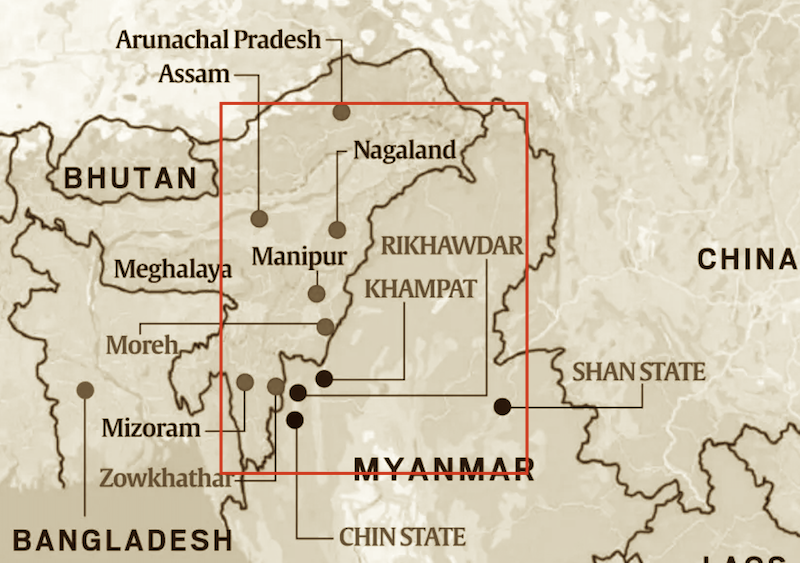Should India Retain the Free Movement Regime (FMR)?
Syllabus:
GS-2:
India and its Neighbourhood , Effect of Policies & Politics of Countries on India’s Interests
Focus:
In February 2024, Union Home Minister Amit Shah announced the decision to scrap the Free Movement Regime (FMR) along the India-Myanmar border, citing security concerns. However, no official notification or bilateral agreement has been issued, and states like Mizoram and Nagaland oppose the decision due to ethnic and cultural ties.
Background and Overview of the Free Movement Regime (FMR):
Introduction to FMR
- The Free Movement Regime (FMR), established in 1968, allows people residing along the India-Myanmar border to move freely up to 16 km on either side without visas.
- It aims to maintain ethnic and familial ties across the 1,653-km-long border shared by the two countries.
- Initially, the territorial limit was 40 km, but it was reduced to 16 km in 2004 with stricter regulations introduced in 2016.
Recent Developments
- In February 2024, Union Home Minister Amit Shah announced the decision to scrap the FMR due to security concerns, especially following ethnic conflicts in Manipur.
- This decision was reportedly influenced by Biren Singh, former Chief Minister of Manipur.
- However, Mizoram and Nagaland have opposed this decision, and no formal notification or bilateral agreement has been finalized.
Impact of FMR on Border Communities
Socio-Economic Benefits of FMR
- The FMR facilitates trade, cultural exchanges, and kinship ties between communities living across the border.
- Henry Zodinliana Pachuau noted that cross-border trade and movement existed long before the FMR, contributing to economic growth and cultural integration.
- Likhase Sangtam emphasized that the border was drawn without community consent, leading to a situation where the border communities remained unaffected by FMR regulations.
Challenges Posed by FMR
- The unregulated movement of people has allegedly aggravated ethnic tensions in Manipur, with claims of illegal migration and smuggling.
- Contraband goods such as drugs, gold, and areca nuts are frequently smuggled into India, leading to a surge in illegal activities.
Security Concerns and the FMR Debate
Security Challenges at the India-Myanmar Border
- The Centre’s decision to scrap the FMR is driven by security concerns to curb migration and cross-border crimes.
- The Border Area Development Programme (BADP) initiated in the 1980s aimed to strengthen border security, but illegal smuggling continues.
- Henry Zodinliana Pachuau argues that scrapping the FMR may not effectively stop cross-border crimes.
Practicality of Fencing the Border
- The idea of erecting a border fence along the 1,653-km border is seen as impractical by experts.
- Henry Zodinliana Pachuau pointed out that even advanced countries like the United States have struggled with border fences.
- Likhase Sangtam highlighted the challenges of community resistance and geographical constraints in implementing a border fence.
- Concerns have been raised that fencing could disrupt cultural and familial ties.
Implications of Fencing on Ethnic Unity and Homeland Demands:
Potential Impact on Ethnic Sentiments
- The proposed fence could fuel demands for a unified homeland for border communities with ethnic and cultural ties.
- Henry Zodinliana Pachuau emphasized the resentment among communities who feel the border was imposed upon them.
- The Forest (Conservation) Amendment Act, 2023 adds to concerns by permitting strategic projects within 100 km of international boundaries, potentially affecting ancestral lands.
Risks of Escalating Regional Tensions
- Likhase Sangtam warned that a coercive approach could reignite demands for Frontier Nagaland and a common homeland.
- The lack of representation, high unemployment, and economic neglect in the region could intensify these demands.
- A tactful approach is essential to avoid alienating local communities.
The Way Forward: Reforms and Alternatives to FMR:
Alternatives to Scrapping FMR
- Henry Zodinliana Pachuau suggests a regulated monitoring system with effective border management instead of fencing.
- Legalizing cross-border trade could generate revenue and address smuggling issues.
- Regular dialogues and cooperation between border authorities of both nations could enhance security.
- The focus should be on empowering local communities and making them stakeholders in border management.
Building Consensus for Long-Term Solutions
- Likhase Sangtam stressed the importance of educating people and taking them into confidence before implementing border measures.
- India should pursue a balanced approach that ensures security while respecting cultural and ethnic ties.
- The Act East Policy should include provisions for economic development, infrastructure, and employment in border areas.
- Establishing cross-border trade hubs and easing restrictions can foster regional integration.
Conclusion:
The decision to scrap the Free Movement Regime along the India-Myanmar border requires a nuanced approach. While addressing security concerns is crucial, fencing the border is not a feasible solution. The government must consider alternative measures such as regulated monitoring, legalizing trade, and fostering cooperation. A collaborative approach involving border communities will ensure effective border management while preserving cultural and ethnic ties.
Source: TH




